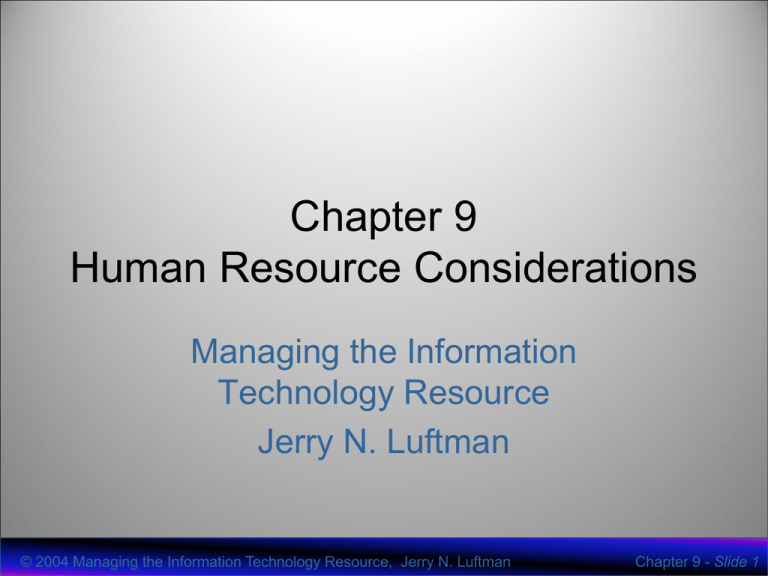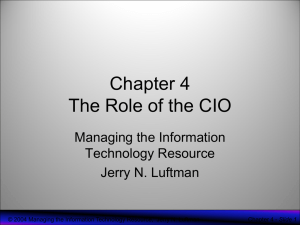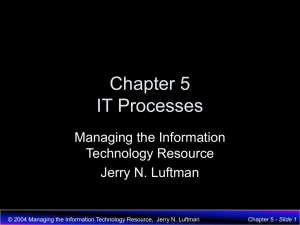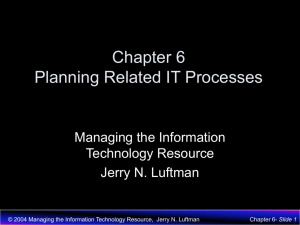Slide 1
advertisement

Chapter 9 Human Resource Considerations Managing the Information Technology Resource Jerry N. Luftman © 2004 Managing the Information Technology Resource, Jerry N. Luftman Chapter 9 - Slide 1 Chapter Outline • Market for IT professionals • What IT professionals seek in a position • Characteristics of IT environment contributing to HR complexity • Future for IT professionals • Skills required for successful IT future • Retention of IT talent • Stress in the workplace • IT career development © 2004 Managing the Information Technology Resource, Jerry N. Luftman Chapter 9 - Slide 2 National Average of IT Salaries • CIO/VP of IT – $165,100 • Director of IT/IS/MIS – $108,200 • Project Manager – $88,200 • Database Manager – $84,800 • Senior Systems Analyst – $72,300 • Senior Systems Programmer – $68,900 • Web Application Developer – $61,700 • Network Administrator – $60,000 • Programmer/Analyst – $55,100 • Help Desk Operator – $39,700 © 2004 Managing the Information Technology Resource, Jerry N. Luftman Chapter 9 - Slide 3 What IT Professionals Are Looking For • • • • • • • • Career advancement Salary requirements Empowerment to affect company success Ability to telecommute Discuss career goals with management Reasonable workload Company-sponsored training and seminars Less stress © 2004 Managing the Information Technology Resource, Jerry N. Luftman Chapter 9 - Slide 4 © 2004 Managing the Information Technology Resource, Jerry N. Luftman Chapter 9 - Slide 5 Top IT Jobs in Percentage of Growth • Computer Engineer – 108% • Computer Support Specialist – 102% • System Analyst – 94% • Database Administrator – 77% • Desktop Publishing Specialist – 73% © 2004 Managing the Information Technology Resource, Jerry N. Luftman Chapter 9 - Slide 6 Skills for Future in IT • • • • • • • Business analyst Change management Communication Finance Project management Leadership Managing value • Marketing • Mentoring/career development • Stakeholder management • Team building • Training © 2004 Managing the Information Technology Resource, Jerry N. Luftman Chapter 9 - Slide 7 General Technology Skills Needed • • • • • • • Application software Databases Hardware infrastructure/architecture Knowledge of general IT management issues Networks and networking architecture Systems development and programming Integration within and across all architectures © 2004 Managing the Information Technology Resource, Jerry N. Luftman Chapter 9 - Slide 8 Industry and Firm-Type Knowledge • Industry Knowledge – Best practices – Industry issues – Industry-specific solutions • Firm-Type-Specific Knowledge – Business processes – Generalized business strategies – Influencing decision making – Marketing © 2004 Managing the Information Technology Resource, Jerry N. Luftman Chapter 9 - Slide 9 Necessary Managerial Skills • Ability to communicate across business disciplines • Ability to employ consulting skills • Ability to influence decision making • Information about business process • Understanding organizational philosophy • Understanding the strategic goals and objectives © 2004 Managing the Information Technology Resource, Jerry N. Luftman Chapter 9 - Slide 10 Becoming a First-Line Manager • • • • Become responsible for output of other people Act as leader Stay informed on technical issues Acquire new and unfamiliar administrative duties • Deal with employees and their problems • Face new situations that have unclear action requiring judgment © 2004 Managing the Information Technology Resource, Jerry N. Luftman Chapter 9 - Slide 11 Problems of Retention of IT Talent • Difficult to know how to plan to use human resources • Disruptive to organization and negative impact on morale when talented workers leave • Real costs of losing skilled employees and replacing them © 2004 Managing the Information Technology Resource, Jerry N. Luftman Chapter 9 - Slide 12 Recruiting IT Talent Source: Lee Hecht Harrison, Inc., http://www.lhh.com/us/rsrchinfo/res&info.html © 2004 Managing the Information Technology Resource, Jerry N. Luftman Chapter 9 - Slide 13 Gartner’s Successful Retention Guidelines • Compensation – Pay within 10% of market rates – Integrate HR and IT functions – Allow IT function managers greater flexibility – Build defensive intelligence sources and survey often – Set aside money for training that vests over time – Offer time- and performance-based bonuses that pay out over 3-5 year period – Stock options © 2004 Managing the Information Technology Resource, Jerry N. Luftman Chapter 9 - Slide 14 Gartner’s Successful Retention Guidelines • Benefits – Health, dental, and vision – Financial benefits include • • • • 401-K Pension plan Employee stock purchase plans Tuition/education reimbursement – Lifestyle benefits • • • • Casual dress Telecommuting Flexible hours Sabbaticals © 2004 Managing the Information Technology Resource, Jerry N. Luftman Chapter 9 - Slide 15 Gartner’s Successful Retention Guidelines • Training – Invest at least 10% in training and upgrading skills • Work Environment – Provide chance to work with new technologies – Make work environment fun – Recognition programs © 2004 Managing the Information Technology Resource, Jerry N. Luftman Chapter 9 - Slide 16 Gartner’s Successful Retention Guidelines • Eliminate Burnout Through Staffing/Time Off – Staff to meet objectives, negotiate service levels, increase after-hours premium support – Offer time-off to employees who put in long hours • Poll Employees – Employee satisfaction data once a year – 360° review process – Implement skip-level lunches to gain better insight © 2004 Managing the Information Technology Resource, Jerry N. Luftman Chapter 9 - Slide 17 Gartner’s Successful Retention Guidelines • Hire Appropriate Profile – Beware of “go-getters” – Understand person’s cultural fit within organization • Open Career Paths – NO artificial boundaries on career ladders – Allow people to build process management skills © 2004 Managing the Information Technology Resource, Jerry N. Luftman Chapter 9 - Slide 18 © 2004 Managing the Information Technology Resource, Jerry N. Luftman Chapter 9 - Slide 19 Source: Personnel Decisions Inc., Minneapolis, MN, http://www.personneldecisions.com © 2004 Managing the Information Technology Resource, Jerry N. Luftman Chapter 9 - Slide 20 Motivation Factors for IT Staff • • • • • Allow people to learn new technologies Give people necessary resources Be competitive in terms of salary and benefits Provide for worker’s personal development Provide strong leadership during rapid change • Make certain people perceive that work is meaningful © 2004 Managing the Information Technology Resource, Jerry N. Luftman Chapter 9 - Slide 21 Common Sources of Stress • Pace of technology change • Commuting • Work-life balance • Office politics • Increasing workloads • Other © 2004 Managing the Information Technology Resource, Jerry N. Luftman Chapter 9 - Slide 22 Greatest Sources of Workplace Stress Pace of technology change, 1% Other or don't know, 4% Commuting, 4% Work-life balance, 12% Office politics, 24% Increasing workloads, 55% © 2004 Managing the Information Technology Resource, Jerry N. Luftman Chapter 9 - Slide 23 Stress-Reduction Techniques • Bring in outside contractors to reduce workloads • Improve communications and encourage team building • Involve employees in decisions about managing workloads • Plan and promote outside activities to break monotony © 2004 Managing the Information Technology Resource, Jerry N. Luftman Chapter 9 - Slide 24 IT Management Can Reduce IT Staff Stress • • • • • • Keep staff updated on project status Let people know what is expected Set priorities Manage deadlines Make sure staff takes breaks regularly Make sure staff knows updates on latest developments © 2004 Managing the Information Technology Resource, Jerry N. Luftman Chapter 9 - Slide 25 IT Management Can Reduce IT Staff Stress • • • • • • • Arrange for massages/exercise Arrange for well-balanced food Encourage work with “stress buddies” Keep stress diary Encourage time off if highly stressed Encourage staff to ask for help Provide ergonomic work environment © 2004 Managing the Information Technology Resource, Jerry N. Luftman Chapter 9 - Slide 26 Career Development • • • • • Personal career development Increased quality of work Improved capacity to solve problems Better team performance Improved capacity to cope with change in workplace • Higher success rate in promoting employees • Increased output of products and services • Increased employee retention © 2004 Managing the Information Technology Resource, Jerry N. Luftman Chapter 9 - Slide 27 Ethical Conduct and Data Management • Provide training in ethical conduct • Employees understand rules of ethical behavior and actions • Enforce ethical conduct on management of firm • Bring visibility to all information • Formal and on-the-job • Can cover broad range of topics © 2004 Managing the Information Technology Resource, Jerry N. Luftman Chapter 9 - Slide 28 Six Commandments of Ethical Management • Data is valuable corporate asset. • CIO is steward of corporate data and responsible for managing it over its life cycle. • CIO is responsible for controlling access to and use of data. • CIO is responsible for preventing inappropriate destruction of data. • CIO is responsible for brining technological knowledge to development. • CIO should partner with executive peers to develop and execute data management policies. © 2004 Managing the Information Technology Resource, Jerry N. Luftman Chapter 9 - Slide 29 © 2004 Managing the Information Technology Resource, Jerry N. Luftman Chapter 9 - Slide 30









